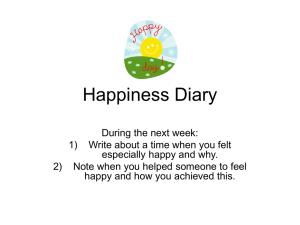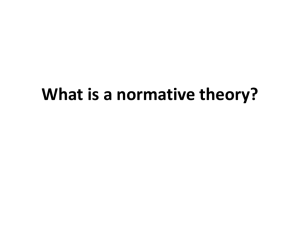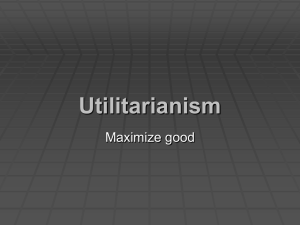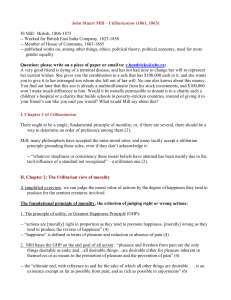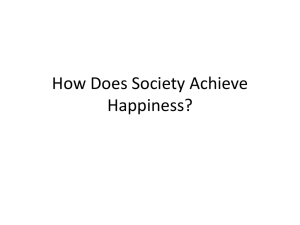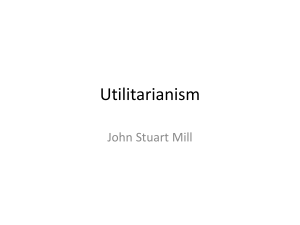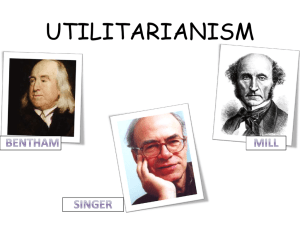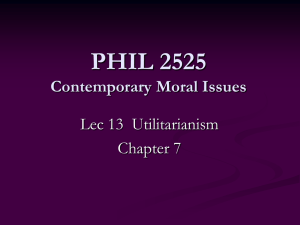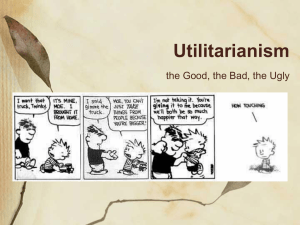Handout week 2
advertisement
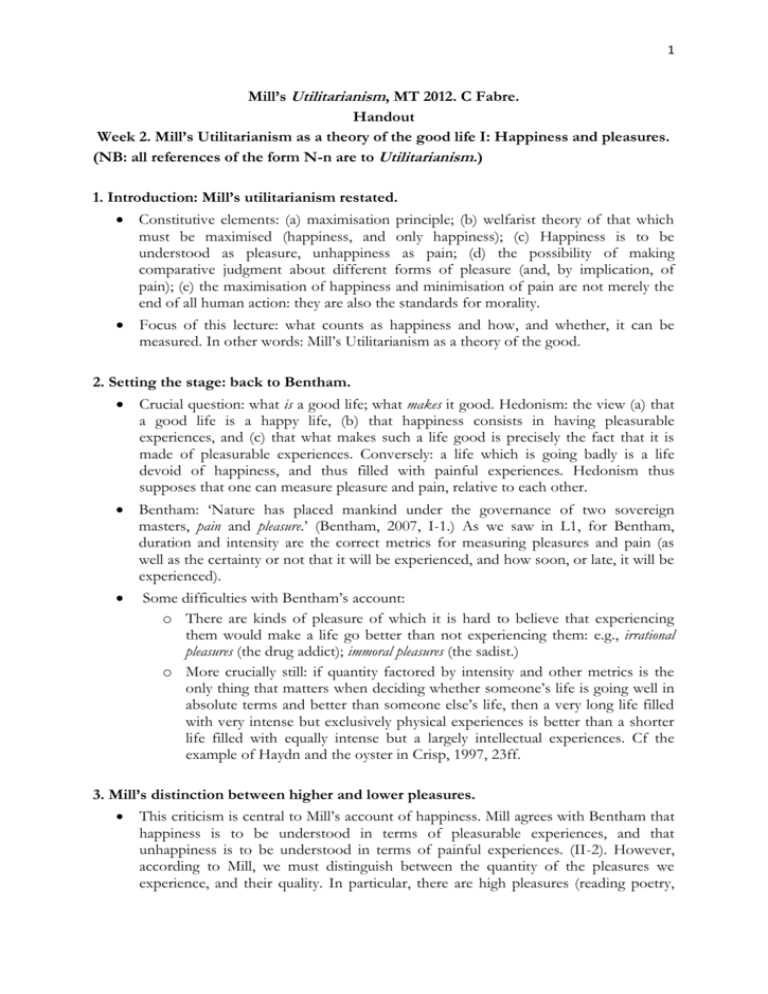
1 Mill’s Utilitarianism, MT 2012. C Fabre. Handout Week 2. Mill’s Utilitarianism as a theory of the good life I: Happiness and pleasures. (NB: all references of the form N-n are to Utilitarianism.) 1. Introduction: Mill’s utilitarianism restated. Constitutive elements: (a) maximisation principle; (b) welfarist theory of that which must be maximised (happiness, and only happiness); (c) Happiness is to be understood as pleasure, unhappiness as pain; (d) the possibility of making comparative judgment about different forms of pleasure (and, by implication, of pain); (e) the maximisation of happiness and minimisation of pain are not merely the end of all human action: they are also the standards for morality. Focus of this lecture: what counts as happiness and how, and whether, it can be measured. In other words: Mill’s Utilitarianism as a theory of the good. 2. Setting the stage: back to Bentham. Crucial question: what is a good life; what makes it good. Hedonism: the view (a) that a good life is a happy life, (b) that happiness consists in having pleasurable experiences, and (c) that what makes such a life good is precisely the fact that it is made of pleasurable experiences. Conversely: a life which is going badly is a life devoid of happiness, and thus filled with painful experiences. Hedonism thus supposes that one can measure pleasure and pain, relative to each other. Bentham: ‘Nature has placed mankind under the governance of two sovereign masters, pain and pleasure.’ (Bentham, 2007, I-1.) As we saw in L1, for Bentham, duration and intensity are the correct metrics for measuring pleasures and pain (as well as the certainty or not that it will be experienced, and how soon, or late, it will be experienced). Some difficulties with Bentham’s account: o There are kinds of pleasure of which it is hard to believe that experiencing them would make a life go better than not experiencing them: e.g., irrational pleasures (the drug addict); immoral pleasures (the sadist.) o More crucially still: if quantity factored by intensity and other metrics is the only thing that matters when deciding whether someone’s life is going well in absolute terms and better than someone else’s life, then a very long life filled with very intense but exclusively physical experiences is better than a shorter life filled with equally intense but a largely intellectual experiences. Cf the example of Haydn and the oyster in Crisp, 1997, 23ff. 3. Mill’s distinction between higher and lower pleasures. This criticism is central to Mill’s account of happiness. Mill agrees with Bentham that happiness is to be understood in terms of pleasurable experiences, and that unhappiness is to be understood in terms of painful experiences. (II-2). However, according to Mill, we must distinguish between the quantity of the pleasures we experience, and their quality. In particular, there are high pleasures (reading poetry, 2 studying philosophy) and lower pleasures (playing pushpin, rolling around in the mud.) Some problems with the distinction between lower and higher pleasures: (a) not clear why intellectual pursuits per se are higher pleasures whilst physical pursuits per se are lower pleasures; (b) Moreover, the dichotomies high/low, higher/lower, are overly simplistic: eating a very delicately cooked and flavoury Indian dish might be plausibly regarded as a higher pleasure than eating an overcooked hamburger. Suppose that one can get a good handle on that distinction. Two issues remain: (a) how do we know that a given experience counts as a higher or lower pleasure? (b) Is the distinction compatible with Mill’s avowed hedonism? 4. Measuring the quality of pleasures: appeal to the competent judge The test of the competent judge: if those who are in a position to make a comparison between, e.g., reading good novels and drinking white wine, judge that doing the former is more valuable than doing the latter, then we can say that reading good novels is a higher pleasure, whilst drinking white wine is a lower pleasure. To be clearer: what makes an experience more valuable than another is not the fact that it is ranked as such by competent judges; rather, the fact that it is ranked as such gives us good reasons to believe that it is more valuable. When there are disagreements between experienced judges, we go with the majority verdict. Pbs with the test: (a) Are any such judges to be found, who can evaluate very different kinds of pleasure? (b) Relatedly: implausible to think that someone could have experienced the life of a fool and the life of a philosopher; (c) In any event, the fact that intelligent and educated persons would not choose the life of a fool does not show that intellectual pleasures per se are higher pleasures; all it shows is that the life of a fool would be bad for them; it could still be a very good life for the fool (See Skorupski, 1989, 306).; (d) Finally, there is an ambiguity in Mill’s test (for good discussions see Anderson, 1991;Crisp, 1997.) Does the test apply to pursuits (reading good novels, drinking white wine on balmy summer evenings) or to instances of such pursuits? 5. Lower pleasures, higher pleasures, and the greatest happiness principle. Recap: Mill rejects Bentham’s account of happiness for relying on too simplistic an understanding of (a) the nature of pleasures, and (b) the best way to measure them. Instead, we must recognise that there are different kinds of pleasure and that the quality of those pleasures matters for the measurement of happiness. Greatest Happiness principle: ‘actions are right in proportion as they tend to promote happiness, wrong as they tend to produce the reverse of happiness.’ (II). The Principle applies to happiness so construed. A standard, and serious objection (for references and long discussions, see Brink, 1992;Crisp, 1997): Mill cannot draw the distinction between lower and higher pleasures, and remain a hedonist - or at least (in Crisp’s terminology) a full hedonist. Hedonism is the view (a) that a good life is a happy life, (b) that happiness consists in having pleasurable experiences, and (c) that what makes such a life, and its constituent experiences, good, is precisely the fact, and only the fact, that those experiences are pleasurable. Objection: either experiences such as reading are better than others such as drinking precisely in so far as they are more pleasurable; or they are better in virtue of their intrinsic properties, irrespective of the fact that they are 3 pleasurable. Those intrinsic properties are (e.g.) nobility of purpose; advancement of knowledge, etc. The first claim is consistent with hedonism, in fact seems to flow from it, but then the distinction between lower and higher pleasures adds nothing at all to Bentham’s original view: we rank pleasant experiences on the basis of their greater degree of pleasurableness (and the initial pbs with Bentham’s view remain.) The second claim preserves the improvement on Bentham, but then it is not clear at all that Mill really is a hedonist – in fact, it is not clear at all that he can endorse the Greater Happiness principle. For on that view, some experiences have good-making properties which are not reducible to pleasures (contra hedonism). And if that is the case, then presumably the promotion of happiness is not the only criterion for rightness that there is: so is the promotion of those other values. A possible solution for Mill: to insist that what makes an experience or pursuit more valuable than another is the fact of its pleasurableness, that one can derive pleasure in the realisation of intrinsically noble experiences, and it is only in so far as one derives such pleasure in those experiences that they contribute to our happiness. Thus, an experience or pursuit which is noble but not pleasurable does not contribute to a good life. (Cf Anderson, 1991;Crisp, 1997, for good accounts. Brink takes the opposite view and argues that Mill is simply not a hedonist.) 6. Concluding remarks.
